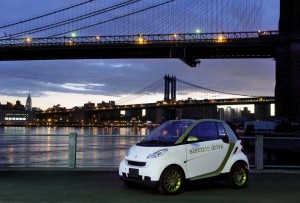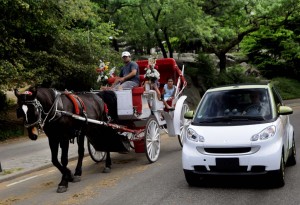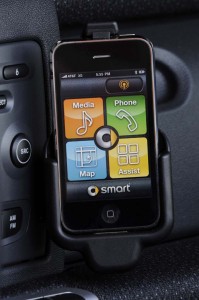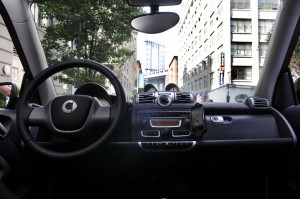
Will Smart find 250 customers for the battery version of its fortwo microcar -- at twice the price and with an 82-mile range?
It’s not the traffic we find ourselves watching out for, though there’s plenty of it on the busy streets of Brooklyn, but the potholes, massive gaps in the pavement that yawn wide and threaten to engulf our entire little microcar.
It’s not a job but an adventure, at times, taking tomorrow’s cars out for a ride, though few draw as many glances – some admiring, others just agape — as the 2011 Smart fortwo Electric Drive. Call it the ED, for short, a battery-powered version of the French-German microcar.
The auto industry, as a whole, is increasingly coming to embrace the concept of electrification, with plug-in hybrids, like the Chevrolet Volt, and pure battery-electric vehicles such as the Nissan Leaf. Even Mercedes-Benz is exploring its options, all the way up to a battery-powered version of its SLS supercar.
But the German maker’s sibling brand, Smart, seems especially well-suited to enter the electric field, delivering a battery version of its nimble little two-seater that was already targeted to the urban market.
Smart will launch sales of 250 EDs in the U.S., late this year, complimenting the fleet of more than 1,500 it will put on the road in Europe. Plans call for launching full retail sales in 2012 as a 2013 model. But the maker hopes to learn a lot, by then, as the original crop of guinea pigs, er, buyers put their EDs through the rigors of daily motoring.
(Click Here to see how Smart is betting on the ED to revive the brand.)
To get a sense of what they’re likely to discover, I headed to Brooklyn, earlier this week, where I squeezed into a fully-charged microcar alongside my colleague from TheDetroitBureau.com, Joe Szczesny.

The original Smart fortwo was designed as an urban microcar and though it is getting a bit old, the basic platform does lend itself to an electric powertrain designed for urban motoring.
But for the vivid green decals one might not notice this was anything other than a conventional smart fortwo –from the outside, anyway. Inside, there were several telltale signs, including the gauges and the iPhone sitting in a cradle mounted atop the center stack. The Apple device displayed a special “app” specifically developed for Smart ED owners. But more on that in a moment.
Like other electric vehicles, starting the Smart ED can be a bit disconcerting. There’s no engine noise, just a series of lamps and gauges lighting up. In fact, even at 40 mph, there’s only the most subtle motor whine and a moderate amount of tire noise.
Slipping into traffic we found the ED more than able to maintain its place on the borough’s narrow side streets. Indeed, it proved itself surprisingly quick off the line when we reached wider Flatbush Avenue, edging out a cabbie that thought he’s cut in front.
The 30 kilowatt motor translates into a seemingly anemic 41 horsepower, but it also generates 88.5 lb-ft of torque, and as with all electric motors, that tire-spinning power comes on as soon as you step on the throttle, in contrast to a gasoline engine. The Smart ED will launch from 0 to 60 kmh, (about 37 mph) in just 6.5 seconds. But at that point it largely runs out of steam, to mix our metaphors, and there’s going to be a long wait til you top 60 Miles per hour.
Unlike the conventional Smart fortwo, the ED uses a single gear. That’s a definite plus considering the conventional “smart shift” in the gasoline car is probably the vehicle’s single worst feature.
The fortwo’s short wheelbase is an advantage when it comes to dodging and turning on narrow, crowded streets. It’s as nimble as anything available on the New York market. But the downside is that this also makes it more vulnerable to bumps and potholes, which can seem like you’re going from mountain to forest in just a couple feet.
We’d also like to see a little enhancing to the shocks, which do little to shield the car’s intrepid driver and passenger from bone-jarring jolts.
As with all electric vehicles, the Smart ED has relatively limited range. Its lithium-ion batteries (which, incidentally, are shared with the Tesla Roadster) get 82 miles on a charge. While that’s even less than the 100-mile Leaf, Smart insists the ED will more than meet the demands of city drivers who may only clock a few miles a day.
The maker expects the first 250 customers to recharge only once or twice a week. That process will take as much as 14 hours using standard 110 volt power, but with a special 220V unit, that will be trimmed to about 8 hours. And for those who only go to an 80% recharge, that will take as little as 4.5 hours.

Smart has developed a special iPhone app specifically for ED buyers, offering the ability to check charging status, tune into Internet radio and even find your car when you're lost.
The smart charger from Coulomb will allow a motorist to automatically delay charging until off-peak hours. Many American utilities are discussing special battery-car rates that could cut the cost of electricity to a couple cents a kilowatt-hour, compared to the national average of around 10 cents per kWh. That would bring the cost per mile down to as little as a tenth of what you would pay using gasoline, Smart officials noted. (A similar figure to what others in the industry are quoting.)
Which brings us back to the special iPhone app. The Coulomb charger will be able to link to the Internet and, in turn, communicate with the smartphone application, letting an ED owner know the vehicle’s charge status.
The app also offers a minimal mapping feature – which Smart plans to enhance for turn-by-turn – and even an Internet radio service. Plug it into the cradle and choose from over 10,000 Internet stations, from the online version of your local rock outlet to a new station in Camaroon, if you so desire. The downside here is, yep, as any iPhone owner can tell you, AT&T. In the midst of busy Brooklyn, we found the signal dropping out about every half mile for at least a couple seconds.
Who’ll buy the 2011 Smart ED? The maker claim it already has a long list of interested customers. But it also acknowledges that about 80% of those who’ll eventually take deliver are corporate or government buyers.
More accurately, make that lessees. The plan is to offer the initial batch of EDs for $599 a month on a four-year lease, with a down payment of $2,500 bringing the total cost to $31,252, about double what you’d pay for the same little car with a conventional gasoline engine. And you’re limited to just 10,000 miles a year – though few Smart ED customers will likely exceed that number.
Surprisingly, that’s several hundred dollars a month less than what Smart is charging under a similar European pilot program – where demand has been strong enough to force the maker to boost planned volumes from 1,000 to 1,500.
The current plan is to commence full retail sales of the Smart ED in 2012 as a 2013 model. The Daimler AG subsidiary isn’t sure what it will charge by then – its planners believe that the most costly part of the vehicle, the LIon battery, could drop in price as much as 25% by then – nor whether it will continue to stress leasing.
The pilot program, incidentally, will focus on five key markets: Portland, San Jose, Orlando, Indianapolis and the I-95 corridor running from Boston to Washington, D.C.
The maker hopes this pilot program will teach it a lot about not only how the ED holds up but about how customers use the little battery microcar. Jill Lajdziak, the head of Smart’s U.S. distributor, said she plans to personally meet with all 250 battery car pioneers.
If our own experience is any indication, they’ll have a lot to say. The Smart ED is, in many ways, a fun car to drive. It’s a pleasant surprise to get such a strong launch that’s perfect for city streets. But the underlying harshness of the fortwo platform will set nerves ajar.
Nonetheless, if we had the opportunity to add a Smart ED to our fleet and didn’t mind the hefty price premium, we’d be among the initial hand-raisers.

